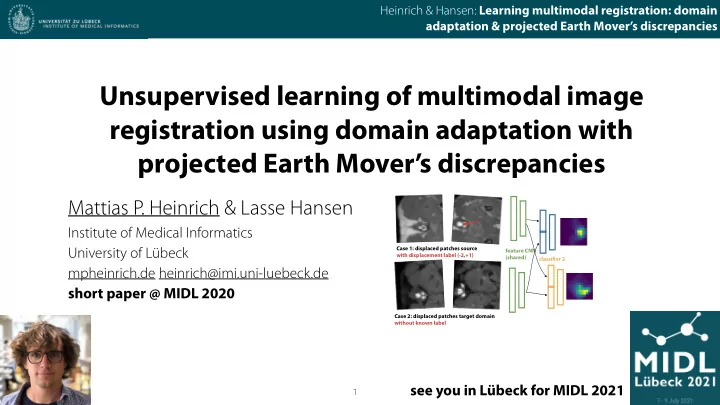

Heinrich & Hansen: Learning multimodal registration: domain adaptation & projected Earth Mover’s discrepancies Unsupervised learning of multimodal image registration using domain adaptation with projected Earth Mover’s discrepancies Mattias P. Heinrich & Lasse Hansen Institute of Medical Informatics Case 1: displaced patches source University of Lübeck feature CNN with displacement label (-2,+1) (shared) classi fj er 2 mpheinrich.de heinrich@imi.uni-luebeck.de short paper @ MIDL 2020 Case 2: displaced patches target domain without known label see you in Lübeck for MIDL 2021 1 �
Heinrich & Hansen: Learning multimodal registration: domain adaptation & projected Earth Mover’s discrepancies Motivation and basic concept of multimodal domain adaptation multimodal registration has clinical challenges for multimodal DL registration impact but 3/3 DL-approaches failed in 1) features / metrics (useful for unsupervised CuRIOUS US-MRI registration challenge DL-reg) are only well de fj ned for monomodal registration open for participation (MICCAI 2020): 2) ground truth correspondences /labels learn2reg.grand-challenge.org across multimodal scans are extremely rare ultrasound guided brain tumour surgery (MNI McGill) Y Xiao, et al.: Evaluation of MRI to ultrasound registration methods for brain shift correction the CuRIOUS TMI 2019 ➞ unsupervised domain adaptation could be ideally suited to address this problem with deep learning contributions of this paper: 1) employ appropriate setting for domain adaptation for multimodal registration (first time this is done) 2) novel discrepancy metric: projected Earth Mover’s (e ffi cient and accurate approximate implementation) Ganin & Lempitsky: Unsupervised domain adaptation by Backpropagation ICML 2015 � 2
Heinrich & Hansen: Learning multimodal registration: domain adaptation & projected Earth Mover’s discrepancies Discrepancy of classi fj ers domain adaptation source domain with labels, target domain without two di ff erently initialised classifiers, shared feature extractor A) update both feature extractor & classifier: source supervision B) upd. classi fj ers to maximise classifier discrepancy on target C) upd. feature extractors to minimise discrepancy on target ➞ shifts target distributions into B) C) ‘correct’ decision boundaries Saito: Maximum Classi fj er Discrepancy for Unsupervised Domain Adaptation CVPR 2018 discrepancy measure is pivotal in steps B/C sliced Wasserstein (SWD) state-of-the-art for Dirac-like softmax distributions, but it is permutation invariant ➞ not sensitive for spatial displacements in discrete registration Lee: Sliced Wasserstein Discrepancy for Unsupervised Domain Adaptation CVPR 2019 3 �
Heinrich & Hansen: Learning multimodal registration: domain adaptation & projected Earth Mover’s discrepancies Projected Earth Mover’s discrepancy for discrete displacements discrete patch-based registration (25 displacement "classes") classi fj er 1 shared feature extractor - concatenation of fixed and moving predicted supervised with labels on T1 (source domain): cross-entropy loss displacement feature ➞ unsupervised adaptation of feature extractor and classifier for Case 1: displaced patches source probabilities CNN classi fj er 2 with displacement label (-2,+1) (shared) new domain / modality (T2, multi-contrast) p-EMD discrepancy 2D experiments on MICCAI SATA 2013 canine dataset range of displacements: { − 38, − 19, 0, +19, +38} 2 pixels Case 2: displaced patches target domain without known label project 2D to 1D along certain angles cumulative histogram Earth Mover’s distance (EMD) solves optimal transport problem, exact solution for 1D histograms exist Our novel 2D (3D) approximation projects histograms onto 1D using multiple angles followed by cumulative histogram ➞ discrepancy larger if peaks are spatially distant Wermann: A Distance Metric for Multidimensional Histograms CVGIP 1985 4 �
Heinrich & Hansen: Learning multimodal registration: domain adaptation & projected Earth Mover’s discrepancies Initial experimental results and multimodal work-in-progress tricks that help: scale prediction by 0.1 before softmax, supervised update only for classifier 1 with labels combination of 16 projection p-EMD (0-90°) + sliced Wasserstein (SWD)) outperforms state-of-the-art (SWD) by 11% 50% MR/CT slices 6 organs no registration pEMD domain adapt registration label accuracy 44.1% 40% 33.2% 30% 31.9% 20% 10% train MR/ train MR/ multimodal test CT/MR no reg 4% MR MR & CT/CT domain adapt 0% experimental validation (test . . D ) g t + p W e 6 accuracy over epochs) Dice a r 1 S d 50.1% ±19 45.8% ±23 55.1% ±21 60.2% ±18 o ( a n D (6 labels) o M n E - p paper: synthetic patch-based registration only MR T1/T2 new: fully deformable MR-CT (81 real registrations) four blocks of Conv2d, InstanceNorm and PReLU (13k weights) 21x21 (441) displacement labels, graphical model ➞ 18x18 feature map with 16 channels regularisation and instance optimisation as post- processing, ➞ Heinrich Closing the gap.. MICCAI 2019 concatenated for three block classification network (70k weights) ➞ prediction of 25D classification vector dataset ➞ Blendowski Learning .. multi-modal feat. MIDL 2019 5 �
Recommend
More recommend